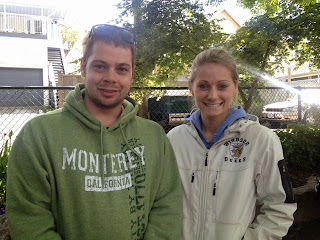 |
| Beautiful chive flowers at the Food Garden section of the Botanical Gardens |
Lesson planning again! The
culmination of this Community Field Experience is the hosting of the Orchard
Garden workshop this coming Saturday. Pailin and I had the privilege of working
with numerous brains on what is essentially a giant four-hour lesson plan. We will be teaching about herbs,
compound butter and culinary math. Collaboration is probably one of my
favourite parts of teaching. With so many brains involved, the lesson begins to
be more layered and varied; our lesson plan reflects that through its auditory,
kinetic and visual elements.
As I mentioned in my previous
blog post, we had direct planted beet seeds into the soil during our first week
and had not seen any signs of growth when we visited last week. This past
Monday, Pailin and I visited the garden to give the plants some water. As we
neared the plant beds, we saw something that caused us utmost shock and
delight: little beet seedlings had
sprouted over the weekend! As a first-time gardener, I was pretty sure that
we had somehow killed our beet seedlings. Maybe we hadn’t given them enough
water. I had all but given up hope on seeing them sprouting.
 |
| Who knew that little sprouts could elicit so much excitement? |
The surface of the soil did not
reveal to us that the seeds were growing and on their way up to the surface.
But indeed they were! As we look at the many students in our classrooms, we
also cannot tell by appearances what is going on under the surface. Oftentimes
when I teach, I wonder, how much are the students really understanding? How
interested are they? There is so much variety in our students, making it a
challenge (but a valuable one to step up to!) for us when lesson and assessment
planning.
“Isn’t it amazing that all the
DNA that is needed for a plant is all right there in a tiny little seed?” It’s
easy to take kids’ growth for granted – both their intellectual as well as
physical. But it is one of the best moments in teaching, when you see the “aha!”
moments and watch them become more mature throughout the year. Students can
surprise us with how much they do know
and how much they want to know. For
example, the elementary school aged students I teach on weekends are constantly
asking questions and are bubbling with curiosity. I hope to, as a teacher,
encourage students to take the path of lifelong learning.
 |
| Practicing for our compound butter demo! A few simple ingredients can automatically make a meal fancier! |
As we prepared for our workshop, Pailin, Toni and I went to the Orchard Garden to collect some herbs for our compound butter demonstration. We collected some parsley, cilantro and dill from the garden to use for our sample compound butter. It was my first time smelling and tasting fresh dill. How different it is from dried dill! The dried dill I have at home is bland and flavourless, good for aesthetic appeal but doing nothing for the taste buds; fresh dill, on the other hand, is tangy and incredibly fragrant. In the Home Economics classroom, we most often use dried herbs in our cooking because of its low price and its longer shelf life, but if we grew fresh herbs in the classroom, we would have the opportunity to use fresh and fragrant herbs in our dishes as well as learn how to plant and take care of herbs.
Because we wanted to learn more
about fresh herbs and their traditional uses, Pailin, Kwesi and I visited the
UBC Botanical Gardens for more information. The UBC Botanical Gardens is tucked
away south of the UBC Campus and is a beautiful garden full of exotic as well
as native plants. It is a “very large walking space” with a variety of plants
to look at and is well-kept; we did not see a single horsetail weed! Our reason
for visiting was the Physic Garden.
 | |
| The Physic Garden |
 |
The past three weeks have been a
wonderful transition between the 10-week practicum and the summer school
session. The variety of activities we did throughout the past weeks gave us gardening
skills that we look forward to passing on to others. We also gained confidence
in the garden as we learned how to identify weeds, prepare beds, direct seed,
water plant beds and uproot old plants. Pailin and I really gained a sense of
ownership of the garden and looked forward to tending it every day. The garden,
which seemed an onerous task to accomplish on our first day, became a place
that we cared about and wanted to see flourish.
Similarly, as we invest time, effort and care into the students that we
teach at school, we also grow to care for them and their wellbeing.
 |
| Chive flowers growing in a crack |



.JPG)





































